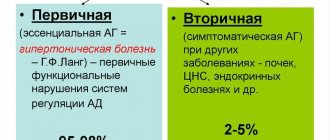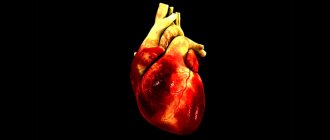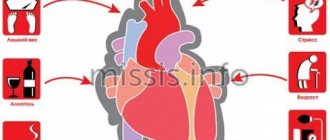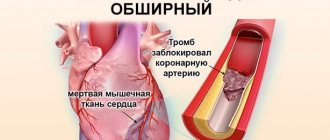Hormones - enemies and defenders
Many people are well aware that there are three main risk factors for heart attacks: age, male gender and heredity.
Article on the topic How to save your heart? The first signs of a heart attack
Everything is clear with the first and third. The second one also has its own explanation. In men, vascular atherosclerosis occurs much earlier due to metabolic disorders. The contributors to these problems are the male sex hormones androgens. But for a woman, the unpleasant process is simply postponed for the time being, because she is protected by sex hormones - estrogens. And while a woman is in an active reproductive period, she faces little risk of cardiovascular disease (unless she inherited a bad heart from her parents and took oral contraceptives, which change hormonal levels). Most often, a woman begins to complain about her heart only during menopause, when estrogen activity in the body decreases.
First aid for heart attack
If acute pain occurs, you must urgently call an ambulance
. In the absence of contraindications, you can take acetylsalicylic acid in a dose of 150-300 mg, after crushing the tablet.
Before the ambulance arrives, the patient must be kept in a reclining position and at rest.
In the room, you need to open the window and unfasten tight clothes and belt.
Doctors call the first hour of the most acute stage of a heart attack “golden”; the outcome of the disease most often depends on this time.
Who takes care of the heart?
But there is also another group of risks - the so-called behavioral ones. Who do you think has a higher risk of developing a heart attack: the poor or the rich? It turns out that the poor man has it. Observations conducted in the United States found that the higher the average annual income in a family, the lower the likelihood that its members will develop heart attacks and strokes in the next ten years. Because rich people have more opportunities to maintain a healthy lifestyle. They are more likely to buy a membership to a fitness club and be more active. If you have money, it is easier to adhere to a healthy eating style - give up fast food, go on a fasting diet, and include healthy foods in your diet that are necessary for the perfect functioning of your heart. And a wealthy patient always has the opportunity to visit a cardiologist on time and conduct the necessary tests.
True, there is a risk factor that is difficult for a person with any income to protect themselves from: stress. Modern man lives under conditions of chronic stress, and the hormones released in this state have the opposite effect of insulin, which lowers sugar levels. The state of constant, elevated levels of glucose in the blood leads to disruption of many metabolic processes and the development of metabolic diseases, the consequence of which is, again, a heart attack.
Catch it if you can. How to prevent a heart attack
More details
Why does a heart attack develop?
This is a special case of coronary heart disease (CHD). With coronary artery disease, the blood supply to any part of the heart is disrupted. The area deprived of blood flow is first damaged, and then may die completely (necrosis). Naturally, the heart muscle, whose job is to contract rhythmically, cannot work normally in this state.
Blood supply may be impaired due to vascular atherosclerosis (approximately 95% of cases), as a result of complications after angioplasty, due to vascular embolization or spasm.
Some people are at higher risk of developing CAD.
Factors that increase risk include:
- High blood pressure;
- Age over 45 years;
- Bad habits (smoking, drinking alcohol);
- Sedentary lifestyle;
- Obesity;
- Diabetes;
- Cases of IHD in the family;
- Detected atherosclerosis or its precursors (high levels of triglycerides of “bad” cholesterol in the blood, low levels of “good” cholesterol);
- Poor nutrition.
What does high cholesterol mean?
How to recognize the threat of an upcoming heart attack? Many patients believe that it is enough to control the level of total cholesterol and the problem can be avoided. It's actually not that simple. The same figure of 5 mmol/l in a 30-year-old woman and a 70-year-old smoking man with arterial hypertension indicates different degrees of risk for developing a heart attack. The doctor should not miss the fact that the man needs urgent help. The prescriptions that a cardiologist will make for a person who has not previously had heart problems and for a patient who has already suffered a heart attack or stroke or has had heart surgery (coronary artery bypass surgery, angioplasty) or suffers from hypertension, diabetes diabetes... Despite the fact that the indicators
Article on the topic
Harmful, but necessary. Are salt, sugar and cholesterol really dangerous? they will have the same treatment, the treatment will be different. Primary prevention is reducing the risk of stroke or heart attack in healthy people who have no complaints, no symptoms, only risk factors. And secondary prevention is the reduction of complications in people who already suffer from cardiovascular diseases.
When the result comes from the laboratory, there is a column on the research form that contains the indicator that is considered the “norm” for healthy people. But this figure should not serve as a guideline for a doctor if his patient is a person undergoing secondary prevention. For example, the same cholesterol. 5.2 mmol/l is the upper limit of normal, and for a person who has suffered a stroke or heart attack, this is already an alarm bell - serious medical intervention is required. The situation is exactly the same with other indicators.
True, the phrase “You have high cholesterol” from doctors today no longer sounds like a sentence. Recently, studies have appeared that have proven that there is no direct connection between high cholesterol levels and cardiovascular diseases. Doubts about this have always existed, but at the end of the 90s of the last century, scientific research provided unexpected data. It turned out that in half of the patients suffering from cardiovascular diseases, heart attack and stroke occur with normal levels of lipid metabolism. Even the term “normolipidemic patient” appeared, i.e. In such a patient, all lipid parameters are normal, but there are problems with the heart and blood vessels. The new concept that today's doctors adhere to says: these normal indicators do not necessarily indicate that there is no atherosclerosis. High cholesterol is just one of the risk factors for atherosclerosis, although it is quite significant.
"Brush" for vessels. What foods will help lower cholesterol levels?
More details
How to avoid myocardial infarction
There are quite a few risk factors for myocardial infarction that a person cannot influence. And their threat can be neutralized if measures are taken in time. We will talk about heart attack prevention measures: what simple actions will help you prolong your life.
Why are preventative measures needed?
Myocardial infarction is a severe form of ischemic disease associated with high morbidity, disability, and mortality. Even during the acute period, it takes many lives with it, causing:
- cardiogenic shock;
- pulmonary edema;
- severe rhythm disturbances;
- myocardial rupture;
- blockage of large pulmonary vessels by thromboembolism.
His danger to survivors does not end there. If, immediately after the immediate threat to life has disappeared, you do not take action to prevent myocardial infarction, a person risks a recurrence of this disease, which in most cases becomes fatal. This is confirmed by scientific research. For example, according to the GRACE study (Global Registry of Acute Coronary Events), in the 5-year period after a cardiac accident, 19% of people who suffered from a form of the disease with ST segment elevation on the cardiogram die, and 22% of those who for whom the cardiogram during a heart attack did not show elevation of this area. During the first year, 86% of people in the first category die, and 68% of those whose ST segment rises above the baseline die.1
Changes in lifestyle, which is the prevention of a heart attack, are important not only for preventing the development of this disease. They have a significant impact on the quality of life.
When to start prevention
Preventive measures should be taken as early as possible, having previously discussed with the attending cardiologist or therapist the possible amount of physical activity. If we are talking about secondary prevention of heart attack, that is, preventing relapse of the disease, then it should begin already at the stage of transfer to the general ward.
How to prevent the disease
The risk of death of a section of the heart muscle increases under the influence of two types of factors:
- Non-modifiable factors that cannot be influenced. This:
- Floor. At a young age, heart attacks most often occur in men; women at this time are “protected” by estrogens in the blood. After 50 years, the chances for men and women are equal.
Age. The older a person is, the greater his “chances” of developing this pathology.
- Heredity. People whose close relatives suffered from cardiovascular diseases (angina, hypertension, cardiomyopathy) are more susceptible to developing the disease.
- Modifiable factors: smoking, physical inactivity, high-fat diet and others. The essence of heart attack prevention is the elimination of these adverse effects.
As scientists say, if you exclude each of the adverse effects, you can resist even a significantly burdened family history and increasing age. Therefore, these factors need to be carefully considered.
Quit smoking
Nicotine and tar, which enter first into the respiratory tract of smokers and then into the circulatory system, double the risk of death of a section of the heart muscle. In addition, they increase the risk of mortality from this disease by 50%. The reason for such a negative effect of tobacco or vaping liquid is the powerful vasoconstrictor effect of nicotine. This leads to the fact that most of the smoker’s organs and tissues, including his heart muscle, experience a constant lack of oxygen.
Therefore, one of the rules for preventing myocardial infarction is to quit smoking. In the absence of other harmful factors affecting blood vessels (for example, hypertension, diabetes), the vascular wall will be restored within a year after quitting smoking. The risk of death of a section of the myocardium is significantly reduced to normal after 3 years.
Increase physical activity
This is the most important part of preventing myocardial infarction and is available to everyone. It is only important to choose it together with a doctor so as not to cause a deterioration in the person’s condition. Optimal activity is considered to be 30 minutes of moderate-intensity aerobic exercise. This is mainly walking, health path, Nordic walking with poles, but other exercises can be selected, depending on the severity of the condition.
If there are no contraindications, exercise for the prevention of myocardial infarction should be carried out at least 3 times a week for 30 minutes. As your condition improves, you should try to exercise 5 times, and then 7 times a week. It is optimal to conduct stress tests to determine the frequency and duration of training.
One large study showed that aerobic physical training carried out for only 3 months already leads to a 30% reduction in the risk of cardiomyocyte death.
Control blood pressure
If the pressure rises above 140/90 mmHg. Art., the risk of not just development, but death from the death of the heart muscle almost doubles. Normal blood pressure for any person, regardless of age, is 120/80 mmHg. Art.
Accordingly, preventing a heart attack involves taking measures to help reduce blood pressure. This:
- Reducing salt intake with food - up to 3 g/day. Sodium chloride leads to edema of the vascular wall, as a result of which the diameter of the arteries becomes smaller, and the pressure in them, accordingly, increases.
- Reduce consumption of coffee and strong tea. Although studies have not yet proven the clear effect of caffeine on blood pressure, most doctors are inclined to believe that drinking more than 3 cups of weak coffee or tea per week increases the production of the stress hormone cortisol, one of the tasks of which is to increase blood pressure.
- Taking blood pressure -lowering medications can prevent a heart attack only if prescribed by a doctor. Self-prescribed medications can worsen the condition and lead to the development of drug-resistant hypertension.
Monitor blood glucose levels
To prevent heart attack, as well as severe complications of diabetes itself, it is important to maintain glucose levels within normal limits: from 3.3 to 6.1 mmol/l. This can be done with the help of modern drugs: tableted hypoglycemic drugs or short-acting insulin in combination with long-acting insulin.
Normalize blood cholesterol levels
An increase in this indicator increases the risk of death of a section of the myocardium by 3%. Cholesterol, or rather, it, together with low and very low density lipoproteins, has the ability to be deposited on the walls of arterial vessels. As a result, the diameter of the artery decreases, and the nutrition of the organ (in this case, the heart) deteriorates. Cholesterol (atherosclerotic) plaques cause the blood to move not in its usual way, but with “swirls” at the site of lipid deposition. The turbulent movement of blood leads to the chipping of areas of plaques, as a result, platelets are attracted here and a blood clot is formed, further reducing the diameter of the vessel.
Therefore, prevention of myocardial infarction will involve lowering cholesterol levels. To do this you need:
- Reduce its supply.
This requires a diet that includes:
- reducing the intake of animal and trans fats: with fatty meat and poultry, fried, smoked foods, mayonnaise, margarine-based baked goods;
an increase in foods containing fiber in the diet: vegetables, fruits, cereals;
- avoiding alcohol, which promotes better absorption of “bad” cholesterol;
- The food of a person involved in heart attack prevention should be cooked stewed, boiled, baked or steamed.
- Neutralize the cholesterol that has already accumulated in the body.
To do this you need:
- Eat foods that contain omega-3 fatty acids, which regulate the ratio of “bad” and “good” cholesterol. These are camelina, olive, flaxseed oil, red fish.
Include oyster mushrooms in your diet, which contain lovastatin, a substance that prevents the liver from forming cholesterol.
- Prevent platelet deposition on plaques.
In most cases, a section of the myocardium dies not because the coronary artery is blocked by an atherosclerotic plaque. The main reason is the detachment of a blood clot from the surface of this lipoprotein deposit. Consequently, prevention of heart attack also consists in reducing platelet deposition on the surface of the atherosclerotic plaque.
For this aspect of heart attack prevention, drugs are used from the group of disaggregants. The standard is acetylsalicylic acid. This substance reduces the content of thromboxane molecules in platelets. As a result, blood platelets do not “stick” to the vascular wall if it is not damaged, and do not form a blood clot there.
One of the optimal antiplatelet agents is Thrombo ACC. These are tablets containing 50 or 100 mg of acetylsalicylic acid, coated with an enteric film coating that will not dissolve in the stomach, affecting local cyclooxygenase. Thrombo ACC dissolves in the intestine, being absorbed from it into the bloodstream. It is intended for long-term use and is indicated for the prevention of myocardial infarction - both primary and secondary. Consequently, it is prescribed both to people suffering from angina, hypertension and arrhythmias, and to those who have already suffered the death of a section of the heart muscle.
Thus, the main pillars of heart attack prevention are a rational diet and increased physical activity. A large international study, OASIS (Organization to Assess Strategies in Ischemic Syndromes. A study evaluating different dosing regimens of clopidogrel and aspirin in different groups of patients with acute coronary syndrome), showed that compliance with these two factors alone reduced the relative risk of the disease by 54%. Quitting smoking is also important: people who gave up this bad habit in the first month after the development of coronary syndrome reduced the risk of repeated death of a section of the myocardium by 43%.
Medicines may also be needed to prevent myocardial infarction. These are glucose-lowering medications, medications to lower blood pressure and normalize cholesterol, and medications that improve metabolic processes in the heart muscle. Drug prevention most often includes taking antithrombotic drugs, for example, Thrombo ACC. They prevent the formation of blood clots on the surface of atherosclerotic plaques, which is the main cause of death of a section of the heart muscle.
*There are contraindications, before use you must consult a specialist
RUS-GPS-THR-NON-01-2019-1455
Heart attack marked "urgent"
The disease acts quickly. Changes in the vascular wall lead to changes in its elasticity and narrowing of the lumen of the vessel. First, ischemia develops (blood supply decreases), and then at some point the plaque ruptures, a thrombus forms in the path of blood flow, it completely blocks the lumen of the vessel and causes necrosis of the myocardium. A heart attack is dangerous because if the blood supply to the myocardium is not restored in the first 6–12 hours after the cessation of blood flow, the heart may stop altogether.
Article on the topic
After a heart attack. What exercises will strengthen your heart?
But even if a heart attack occurs, it should not be fatal. Doctors have several treatment options to prevent a person from dying. It is possible to restore blood supply to the vessel that is closed by a thrombus by using thrombolysis (that is, dissolving the clot). Another way is to restore the patency of the vessel surgically by placing a stent. To do this, a special device is inserted through the artery, which opens in the right place like an “umbrella”, and thus expands and strengthens the vascular wall, restoring blood supply through it. The third method is coronary artery bypass grafting. Its essence is that in those arteries where blood flow is impaired, new bypass paths are created. This is done using healthy vessels that are attached to the coronary arteries.
Moreover, the earlier the diagnosis is made and treatment started, the better the survival prognosis. It is possible to save a person if doctors act immediately - open the lumen of the vessel. But how can you fit into the allotted “window” of 6–12 hours if it is not always possible to make a diagnosis of “heart attack”. 30% of heart attacks pass without pain, nausea, vomiting, or dizziness. In a fourth of cases there are not even changes on the electrocardiogram!
What is bypass surgery?
More details
Symptoms and signs of a heart attack
Typical cases of heart attack are associated with severe pain in the chest, which radiates to the left shoulder, collarbone, neck, left half of the face, lower jaw, and interscapular area. The larger the area of damage to the heart muscle, the more severe the pain. The pain lasts more than 30 minutes and is not relieved by taking medications.
In the atypical course of the acute stage of a heart attack with unexpressed pain, acute weakness, sticky sweat, pale skin, tachycardia, arrhythmia, cough and suffocation, swelling and distorted consciousness may occur.
In the acute stage of a heart attack, the pain usually goes away. Due to necrosis, the temperature may rise and arterial hypotension may develop.
In the subacute period, the condition normalizes, tachycardia and systolic murmur disappear, pressure and temperature normalize.









